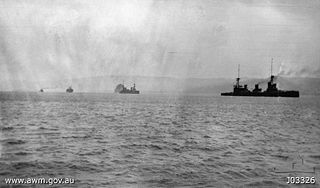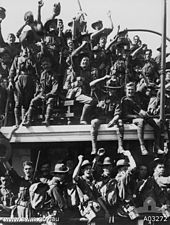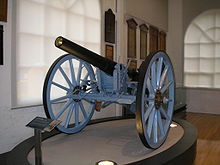Australian Naval and Military Expeditionary Force - Picture
More about World War 1

|
|
Australian Naval and Military Expeditionary Force

Active: 1914
Country: Australia
Allegiance: British Empire
Branch: Army
Type: Infantry
Size: 2,000 men
Commanders:
Commander: Colonel William Holmes
The Australian Naval and Military Expeditionary Force (AN&MEF) was a small volunteer force of approximately 2,000 men, raised in Australia shortly after the outbreak of the First World War to seize and destroy German wireless stations in German New Guinea in the south-west Pacific. Britain required the German wireless installations to be destroyed because they were used by the German East Asian Cruiser Squadron of Vice-Admiral Maximilian von Spee which threatened merchant shipping in the region. Following the capture of German possessions in the region, the AN&MEF provided occupation forces for the duration of the war. New Zealand provided a similar force for the occupation of German Samoa.
History
Formation
The AN&MEF began forming following a request by the British government on 6 August 1914. The force was assembled under the guidance of Colonel J.G. Legge, and was separate from the Australian Imperial Force forming under Major-General W.T. Bridges. The AN&MEF comprised one battalion of infantry of 1,000 men enlisted in Sydney-known as the 1st Battalion, AN&MEF-plus 500 naval reservists and ex-sailors who would serve as infantry. Another battalion of militia from the Queensland based Kennedy Regiment, which had been hurriedly dispatched to garrison Thursday Island, also contributed 500 volunteers to the force. The objectives of the force were the German stations at Yap in the Caroline Islands, Nauru and at Rabaul, New Britain.

Picture - Embarkation of the Australian Naval and Military Expeditionary Force in Sydney
Under the command of Colonel William Holmes, the AN&MEF departed Sydney aboard HMAS Berrima and halted at Palm Island off Townsville until the New Zealand force, escorted by the battlecruiser HMAS Australia, cruiser HMAS Melbourne and the French cruiser Montcalm, occupied Samoa on 30 August. The AN&MEF then moved to Port Moresby where it met the Queensland contingent aboard the transport HMAHS Kanowna. The force then sailed for German New Guinea on 7 September but the Kanowna was left behind when her stokers refused to work. The soldiers from the Kennedy Regiment were also left in Port Moresby as Holmes felt that they were not trained or equipped well enough to be committed to the fighting that was expected.
Landing at Rabaul
Off the eastern tip of New Guinea, the Berrima rendezvoused with Australia and the light cruiser HMAS Sydney plus some destroyers. Melbourne had been detached to destroy the wireless station on Nauru. The task force reached Rabaul on 11 September, finding the port free of German forces. Sydney and the destroyer HMAS Warrego landed small parties of naval reservists at the settlements of Kabakaul and the German gubernatorial capital Herbertshx¶he on Neu-Pommern, south-east of Rabaul. These parties were reinforced firstly by sailors from Warrego and later by infantry from Berrima. A small 25 man force of naval reservists was subsequently landed at Kabakaul Bay and proceeded inland to capture the radio station believed to be in operation at Bita Paka, seven kilometres to the south.
The Australians were resisted by a mixed force of German reservists and Melanesian native police, who forced them to fight their way to the objective. By nightfall the radio station was reached, and it was found to have been abandoned, the mast dropped but its instruments and machinery intact. During the fighting at Bita Paka seven Australians were killed and five wounded, whilst the defenders lost one German NCO and about 30 Melanesians killed, and one German and ten Melanesians wounded. Later it was alleged that the heavy losses among the Melanesian troops was the result of the Australians bayoneting all those they had captured during the fighting. As a result of this engagement Seaman W.G.V. Williams became the first Australian fatality of the war.
At nightfall on 12 September, the Berrima landed the AN&MEF infantry battalion at Rabaul. The following afternoon, despite the fact that the German governor had not surrendered the territory, a ceremony was carried out to signal the British occupation of New Britain. The German administration had withdrawn inland to Toma and at dawn on 14 September, HMAS Encounter bombarded a ridge near the town, while half a battalion advanced towards the town, supported by a field gun.
German surrender

Picture - A German artillery piece captured at Rabaul
The show of Australian firepower was sufficient to start negotiations, ending the Siege of Toma. Terms were signed on 17 September and all military resistance ceased, with the remaining 40 German soldiers and 110 natives surrendering on 21 September. The German colony at Madang on Kaiser-Wilhelmsland (the New Guinea mainland) was occupied on 24 September but the German cruiser SMS Cormoran, which was lurking nearby, escaped undetected. Over the next two months the remaining outposts were occupied. The terms of the surrender allowed the colony's governor, Dr Eduard Haber, to return to Germany while German civilians could remain as long as they swore an oath of neutrality. Those who refused were transported to Australia from where they could freely travel back to Germany.
Although successful the operation was not well managed, and the Australians had been effectively delayed by a half-trained native force. Regardless the Australians had prevailed not least of all because of their unexpected ability to fight close terrain, whilst the outflanking of the German positions had unnerved their opponents. The losses of the AN&MEF were light in the context of later operations but were sufficiently heavy given the relatively modest gain. These loses were further compounded by the disappearance of the Australian submarine HMAS AE1 during a patrol off Rabaul on 14 September, with 35 men aboard.
Following the capture of German possessions in the region, the AN&MEF provided occupation forces for the duration of the war. A military government was subsequently set up by Holmes and continued until 1921 when Australian received a mandate from the League of Nations to govern the territory. Australian administration lasted until 1975 when Papua New Guinea gained its independence.
Gallery
The raising of the Australian flag on 16 December 1914 in Angoram, New Guinea
The submarine AE1 with other Australian ships off Rossel Island on 9 September 1914. On 14 September it inexplicably disappeared during a patrol off Rabaul
Footnotes
Citations
Bean, Charles (1946). Anzac to Amiens. Canberra: Australian War Memorial.
Burnell, Frederick (1915). How Australia took German New Guinea: An Illustrated Record of the Australian Naval & Military Expeditionary Force. W.C. Penfold.
Coulthard-Clark, Chris (1998). Where Australians Fought: The Encyclopaedia of Australia's Battles. St Leonards: Allen and Unwin. ISBN 978-1-86448-611-7.
Dennis, Peter; Grey, Jeffrey; Morris, Ewan; Prior, Robin; and Jean Bou (2008). The Oxford Companion to Australian Military History (Second ed.). Melbourne, Victoria: Oxford University Press. ISBN 978-0-19551-784-2.
Grey, Jeffrey (1999). A Military History of Australia (Second ed.). Port Melbourne: Cambridge University Press. ISBN 0-521-64483-6.
Grey, Jeffrey (2008). A Military History of Australia (3rd ed.). Melbourne: Cambridge University Press. ISBN 978-0-52169-791-0.
MacKenzie, Seaforth (1941). The Australians at Rabaul: The Capture and Administration of the German Possessions in the South Pacific. Official History of Australia in the War of 1914-1918, Volume X. (Tenth ed.). Canberra: Australian War Memorial. http://www.awm.gov.au/histories/first_world_war/volume.asp?levelID=67896.
Odgers, George (1994). 100 Years of Australians at War. Sydney: Lansdowne. ISBN 186302669X.
More aircraft.
Source: WikiPedia